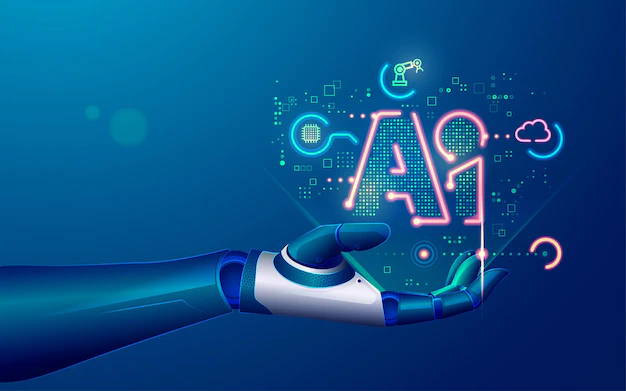The field of Artificial intelligence is experiencing exponential growth, with an expected global rate of 37.3% between 2023-2030, as reported by Grand View Research. This incredible progress is fueled by constant innovation in microprocessor speed, enabling the gathering and storing of vast amounts of data. The rise of AI doesn’t mean that designers are replaced. Instead, it signifies the beautiful blend of AI architecture with human ideas.
One of the most intriguing aspects for designers to consider is the application of AI across creative domains. From AI writing books, creating art, and designing websites to spontaneously generating design solutions- with improved speech and image recognition capabilities, AI is making significant strides in these areas. But how exactly is AI augmenting the design process?
In this article, we will delve into the fascinating domain of AI in design and discover the dynamic relationship between humans and machines in shaping our environment.
Rising Above the Hype
To unlock the true potential of AI in the design world, it’s crucial to dismantle the hype surrounding it. Designers should shift their mindset away from perceiving AI as some mystical technology and instead embrace the concept of “augmented intelligence” in their daily endeavours.
Imagine a design tool powered by AI that enables rapid prototyping: with a simple scan of basic sketches and a few input parameters, a library of UI components springs to life, seamlessly aligning with a company’s design system.
AI also tackles the mundane tasks designers face, including product localisation and creating graphics in multiple languages. By reading the master version, the system generates localised graphics, freeing designers to review, approve, and manually fine-tune if needed—an enormous time-saver.
With a basic design foundation and key parameters, an intelligent AI system can generate a range of design alternatives for designers to choose from based on user preferences. The possibilities for AI augmentation in the design process are vast, empowering designers to push boundaries and achieve greater efficiency and creativity.
Incorporating AI into Your Design Workflow
Incorporating artificial intelligence into design workflows can be a game-changer, offering superpower-like abilities to save time and improve accuracy. Generative design empowers designers with quick and diverse options by setting constraints and goals for AI algorithms.
Image and video recognition capabilities automate tasks like tagging images or identifying key frames. AI-driven user data analysis enhances user experiences by creating personalised interfaces. Moreover, incorporating natural language processing and computer vision enables designers to create interactive experiences through chatbots and virtual assistants. AI truly empowers designers to achieve remarkable results.
Benefits of AI in Product Design and Development
Here are some benefits of using AI in product design and development:
- AI tools automate repetitive and time-consuming tasks, such as generating design variations, running simulations, and conducting tests. This efficiency boost allows designers and engineers to focus on unleashing their creative potential.
- AI enhances decision-making and problem-solving capabilities by analysing vast amounts of data. In the medical device sector, AI algorithms can detect patterns and trends in patient data, leading to the development of more effective products.
- Moreover, AI fosters increased creativity and innovation by harnessing data from diverse sources. By analysing social media data, AI can identify emerging trends and customer preferences, empowering designers to create products that better align with customer needs.
- AI transforms the design landscape and propels the industry forward through improved efficiency, data-driven decision-making, and enhanced creativity.
Case Studies: Example of Successful AI Integration in Product Design and Development
Adidas, the renowned sportswear brand, has embraced the power of AI in revolutionising its product design and development. Implementing AI technology has significantly accelerated their design production timeline, allowing for the creation of new shoe and clothing designs within days, a remarkable improvement compared to the traditional weeks or even months.
Autodesk, a leading software company, has harnessed the potential of AI in product design through their remarkable creation, Dreamcatcher. As an AI-powered design assistant, Dreamcatcher utilises sophisticated algorithms to generate and evaluate numerous design iterations. The software empowers designers to develop products that excel in both performance and efficiency by optimising for crucial factors like strength, weight, and cost.
IBM Watson, a frontrunner in AI innovation, has demonstrated yet another remarkable application of AI in product design and development. Their AI-powered tool is specifically designed to assist designers in creating sustainable products. By harnessing the power of AI, this tool enables designers to analyse the environmental impact of various materials and manufacturing processes. Equipped with this valuable insight, designers can make informed decisions to optimise their product’s sustainability, considering factors such as material choices and manufacturing methods.
The case studies exemplify the advantages of incorporating AI into product design and development. By leveraging AI, companies can enhance their product offerings with improved efficiency, sustainability, and quality.
AI empowers companies to expedite the design process, granting them a competitive edge by enabling faster time-to-market. Integrating AI technology paves the way for creating superior products that meet evolving customer demands while driving business success.
Conclusion
Designers can rest assured. AI and robots are not here to replace them in the foreseeable future. Instead, augmented intelligence opens up a world of exciting possibilities. By collaborating with AI, designers can co-create innovative solutions at the intersection of art, science, engineering, and design.
While this transformation won’t occur overnight, it is inevitable. AI will enhance our intelligence, making us more thoughtful and adept. As we eagerly await this future, designers must stay ahead by expanding their skills. To embark on your UI/UX design journey, Eduonix offers a comprehensive course, User Interface Design Essentials, tailored for beginners. Embrace the future of design with confidence and knowledge.
